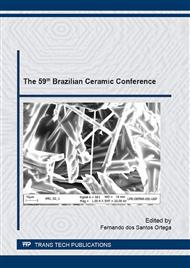p.383
p.387
p.392
p.398
p.404
p.410
p.416
p.422
p.427
WO3:TiO2 Particle Characterization Obtained by High Energy Milling for Application in Photocatalysis
Abstract:
Effective ways to treat textile industrial effluents have been studied in attempt to find alternatives to reduce the imminent risk of water resources contamination. The heterogeneous photocatalysis stands out in this scenario working in the organic waste mineralization, such as dyes. The objectives of this study were to investigate the obtaining of fine powders of the WO3:TiO2 (the investigated proportions in this work were 0: 100; 30:70; 50:50; 70:30; 100:0) using the high energy milling technique and to evaluate the photocatalytic efficiency of the Rhodamine B dye in this system. The oxides precursors were characterized by X-ray diffraction, BET and Helium pycnometry. After dry milling for 4 hours, the obtained powders were characterized by X-ray diffraction and tested to the photocatalysis in UV-C. The results indicate that the milling process has a direct influence on the photocatalytic properties of the investigated systems, and that the greater presence of titania in the mixture leads to a greater catalytic effect.
Info:
Periodical:
Pages:
404-409
Citation:
Online since:
November 2016
Keywords:
Price:
Сopyright:
© 2017 Trans Tech Publications Ltd. All Rights Reserved
Share:
Citation:


